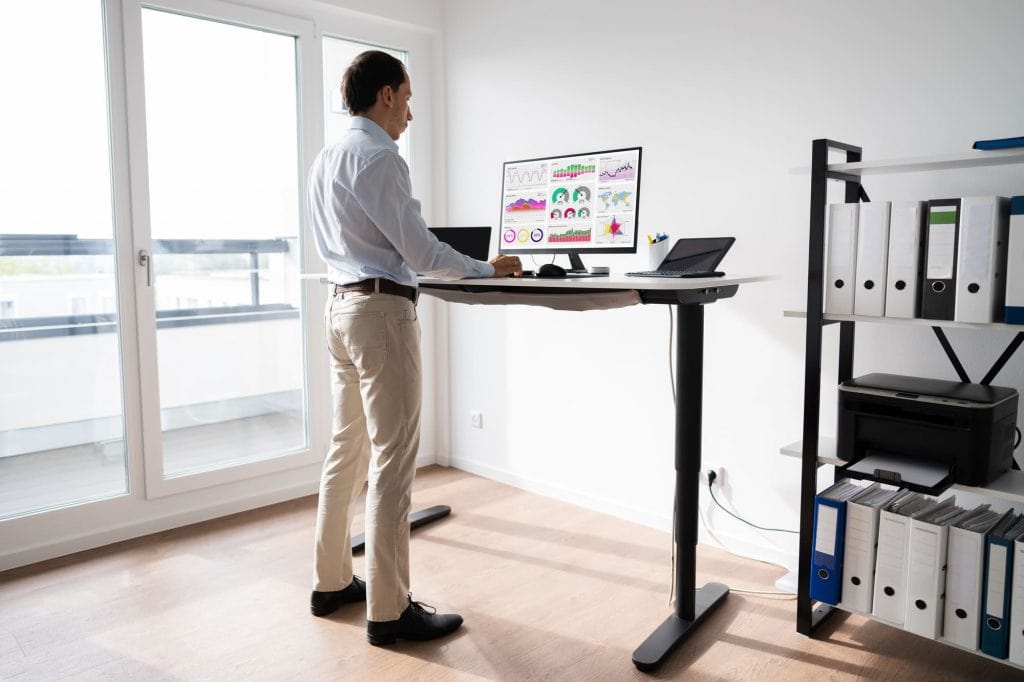*When you buy through links on our site, we may earn an affiliate commission at no additional cost to you.
Burning pain. Tingling sensation. Numbness. Weakness. These are the hallmarks of sciatica that make it a painful and miserable experience. It tends to get the better part of your lower spine, legs, and even feet.
Things get worse if you sit in our office chair all day when you have this condition. And this is where the standing desk comes in to help you avoid too much sitting in your office.
But do standing desks help with sciatica? Does it help alleviate the sciatic pain and discomfort associated with this condition? This is what you’re about to find out in our in-depth post below.
Table of Contents
What is sciatica?

Sciatica is a spine-health-related condition where you feel pain and discomfort due to irritation of the sciatic nerve. The condition arises when a damaged spinal disc becomes degenerative and leads to a herniated disc.
A herniated disc then compresses the sciatic nerve in your lower back, causing pain in your lower back, legs, and feet.
Experts state that up to 40% of men and women will experience this problem during their lifetime.
And according to Medical News Today, people who tend to sit for long periods are at a high risk of developing the problem than those who lead an active life. This puts office workers at an increased risk of getting sciatica.
Sciatica may start as a burning, tingling, numbness, weakness, or a general feeling of discomfort in your lower limbs.
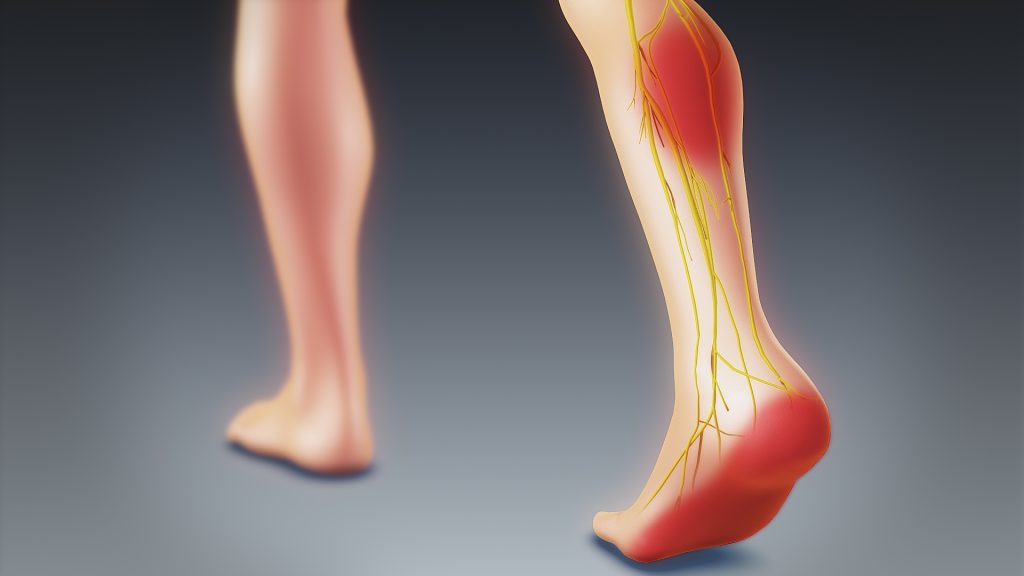
But if you don’t treat it on time, it may grow into a dull or sharp pain that spreads across the entire nerve. And in some cases, it may lead to sudden, stabbing pain in a moment!
Regardless of your case, you should take it with ultimate seriousness and do everything possible to make sure it’s gone. This is due to the simple fact that it involves the sciatic nerve.
For starters, this is the largest nerve in the human body. Since it branches from your lower back through the hips and down each leg, irritating it is the recipe for pain and discomfort in your entire lower body.
How standing desks help with sciatica

Standing desks can help alleviate sciatica because they force you to get off your butt and minimize the pressure placed on the sciatic nerve.
Standing is less troublesome for someone dealing with sciatic pain. This is because it prevents inflammation and aggravation of the already compressed nerve.
A standing desk also promotes subtle movements. And as you may already know, movement is encouraged when you have this condition. This is based on the fact that exercises are one of the most effective ways to deal with this condition.
Just like you shouldn’t sit all day in your office chair, however, you shouldn’t use your standing desk for long hours.
You shouldn’t stand in the same position for long periods. The secret of using your standing desk is moving. For instance, you should take 20 minutes for every standing session to take a walk or stretch your muscles.
Alternatively, you can look for a sit-stand desk to help you easily switch between standing and sitting. This will balance your office life and ensure you don’t spend too much sitting or standing.
How to use a standing desk with sciatica
You should learn how to use your standing desk properly to ensure you get the most out of it. Below, we have discussed some helpful tips on using a standing desk with sciatica.
Alternate between sitting and standing
When using your standing desk for sciatica, we highly advise you to avoid using it for too long hours. Standing for too long can have the same effect as prolonged periods of sitting, including back pains. It may also cause other health problems like varicose veins.
Also read: Do Standing desks improve back pain?
That said, when transitioning to a standing position, consider using it for around 30 minutes to 1 hour and then get to your desk chair. Later on, you can use it for hours when your body gets used to it.
When alternating between a standing desk and an office chair, the rule of thumb is to use them in the standing to sitting ratio 1:1 or 1:2 (i.e., for every hour you stand, be sure to switch to a sitting desk for 1-2 hours).
Take breaks
We also encourage you to take breaks when using a standing desk.
This is for people who work for long hours in the office.
Instead of just switching between sitting and standing throughout the day, consider taking a short walk, stretching in between the standing sessions.
You may even want to set a time so that you don’t forget to take a break.
Remember that movement is key for easing the discomfort.
Plus, your spinal discs receive nutrients through the movement of fluids that occurs during exercise
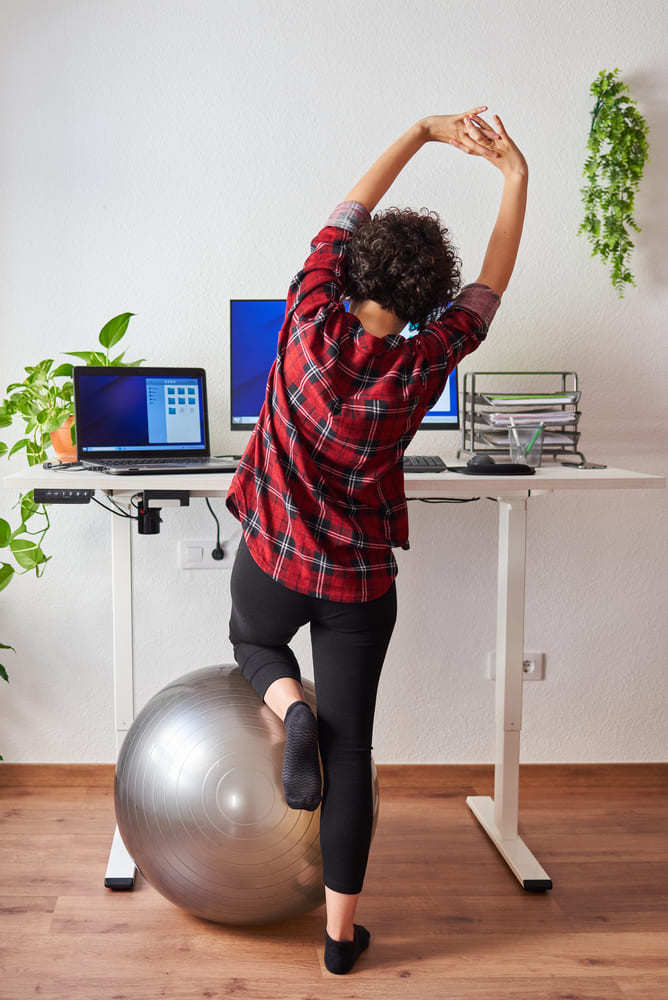
Correct standing posture to fight sciatica pain
You should also ensure you use your standing desk with the correct posture. Ensure your head stays up looking forward, shoulders back, and the elbows bent at 90 degrees so you can comfortably reach your desktop.
Poor posture can worsen sciatica symptoms.
Make yourself comfortable
Before you start using your standing desk, set it correctly to give you a comfortable standing experience.
But how high should your standing desk be? Set your desk surface at a comfortable working height. The monitor should also be at a comfortable height to ensure your back and neck stay in the correct posture while you work.
Still, at it, we also encourage you to stand with your bodyweight equally distributed between the feet.
And keep the ankles, hips, knees, cores, shoulders, and head in line. This promotes good posture, which alleviates pain and discomfort.
Invest in anti-fatigue foot mat
A good standing desk mat promotes micro-movements that help your muscles relax and prevent standing in the same position for too long.
The mat’s sloped, softer surface helps ease the strain on your back. And this can help relieve strain on the sciatic nerve.
The mat also ensures pressure gets evenly distributed throughout your lower limbs, reducing strains in your joints and muscles.
It also promotes good blood circulation and prevents poor posture.
Why sitting is bad for sciatica
Sitting in a desk chair for long hours can cause sciatica. If you already have sciatica, sitting can aggravate the pain and discomfort. This is especially true if you sit in an uncomfortable office chair.

All your upper body weight gets entirely displaced onto your lower back when sitting.
This, in turn, increases compression in and on the spinal discs as explained by Payam Farjoodi, MD, an orthopedic spine surgeon. And the spinal column increases pressure against the nerve roots making up the sciatic nerve.
In other words, a lot of strain is put on discs between the vertebra, making an already squeezed sciatic nerve more irritated.
How to sit when you have sciatica symptoms
In case you don’t have a standing desk to help with sciatica, it is not the end of the road for you. You can still adopt sitting habits that help ease your pain, as discussed below.
Get comfortable behind the desk

Start by adjusting the height of your chair so that your elbows stay at 90 degrees and you can comfortably rest on your desktop and keyboard without straining.
Make sure your feet always touch the floor when you’re sitting and avoid the temptation to close your legs.
You should also set your monitor at a comfortable height and your worktop at a comfortable distance to prevent leaning forward, which can worsen your pain.
Above all, we recommend using a chair with wheels to minimize turning your body awkwardly, further straining your body and causing pain.
Take breaks
Even in the absence of a standing work surface, we still encourage you to look for tasks that you can do while standing on your traditional worksurface.
For instance, you may consider making phone calls and brainstorming while standing. This is a sure way to help ease your pain.
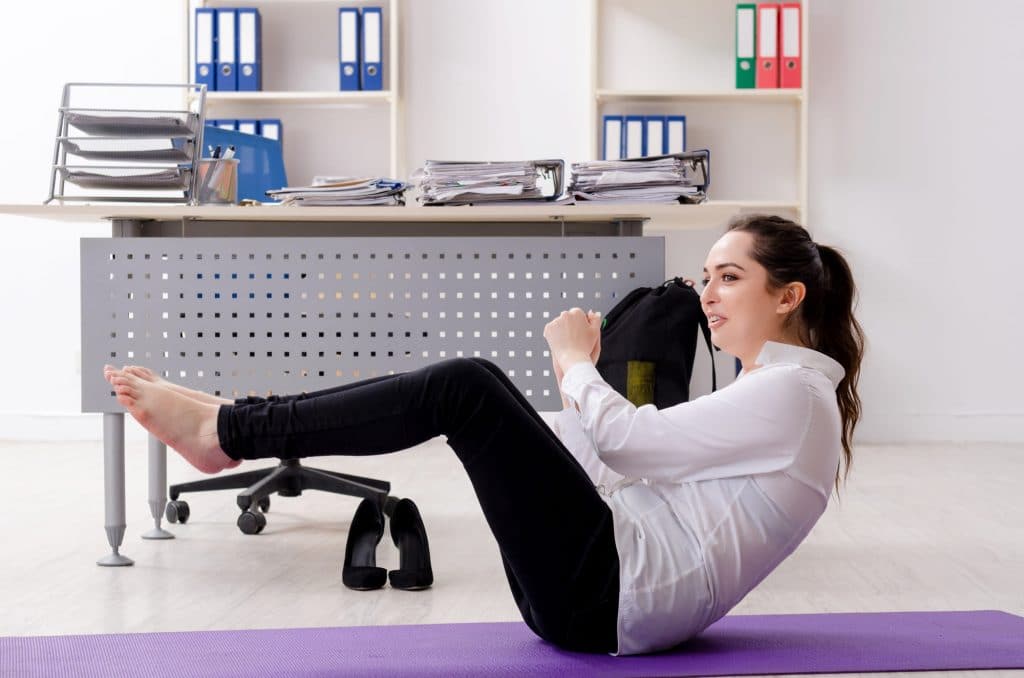
Or you can simply take breaks from your sitting position for about every 30 minutes.
Take walks around your office or do some stretching. This will put your spine health in check by preventing putting strain on it for too long and making your sciatica symptoms worse.
Set a time just in case you forget to take breaks.
Get a chair with good back support
The chair you use should feature good built-in lumbar support. As you already know, the sciatic nerve begins in the lumbar region.
And good lumbar support helps position your back properly and correct your posture. This helps with the relaxation of the necessary muscles and takes the strain off the nerve.
Sitting exercises to relieve sciatic nerve pressure
Besides the above sitting habits, you may also consider doing sitting stretches to help with sciatica.
One such exercise involves sitting in a cross-legged position or with one of your legs crossed over the other (i.e., in figure 4 position).
This can go a long way in relieving sciatica pain.
What’s more, it helps lengthen the piriformis muscle and minimize pressure on the nerve.
Another exercise involves sitting with an open hip angle.
Instead of the standard sitting where you put your feet flat on the floor with your hips, knees, and ankles at 90 degrees, position yourself in a way that allows your hips to open up.
This will reduce compression in your hips and consequently take some straining off the nerve.
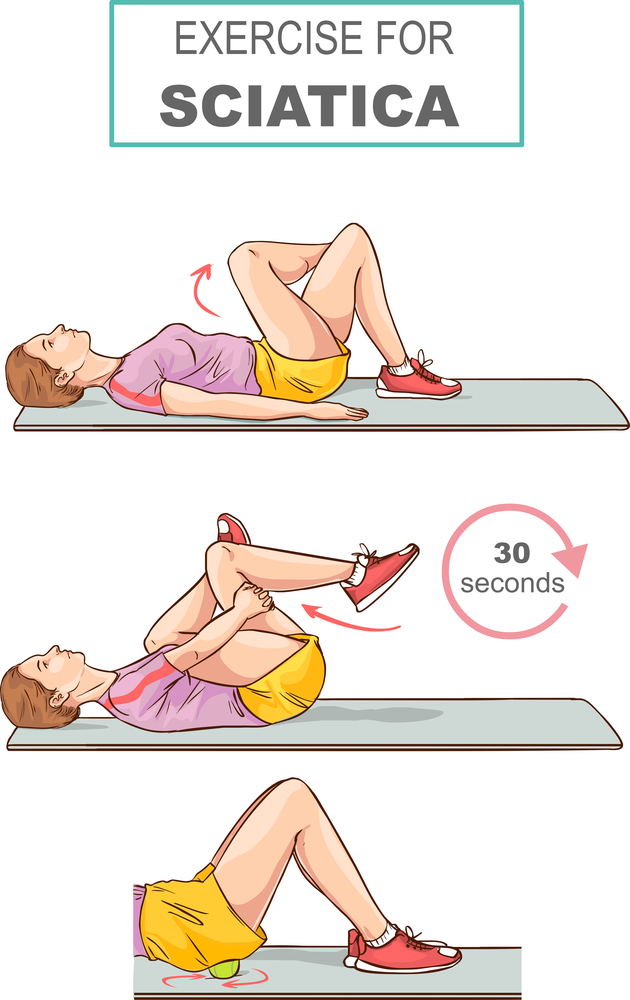
You can also try the nerve glide exercise. This stretch targets the herniated discs, and you can perform it while seated in your office. It helps relax and desensitize the nerve.
This is how you do it:
- Sit upright on your office chair
- Straight one knee while you keep the other flat on the floor
- Slowly bend the ankle of the leg you lifted above so that the toes point toward you
- Continue bending the ankle back and forth as you point the toes towards and away from you.
- To put even more tension on the nerve, try this exercise with your head bent forward while putting your chin near your chest.
- Work your ankle for around 15 to 20 minutes and repeat with the other leg. Aim for 3 rounds for each leg a day for the best results.
Final word

Standing desks make a good solution for sciatica because they encourage staying active while you work.
To benefit from a standing worktop, we advise you to set it to the correct height and stand in the proper posture.
Don’t use your standing desk for long hours when you’re still new to it. Take breaks in between to stretch or walk around to further help with your condition.
Alternating standing with sitting is also a good idea.
Follow our advice above for using a standing desk for sciatica. And you’ll significantly alleviate the sciatica pain and work your office comfortably.
If the sciatica symptoms continue affecting your office work, pay your medical doctor a visit.

